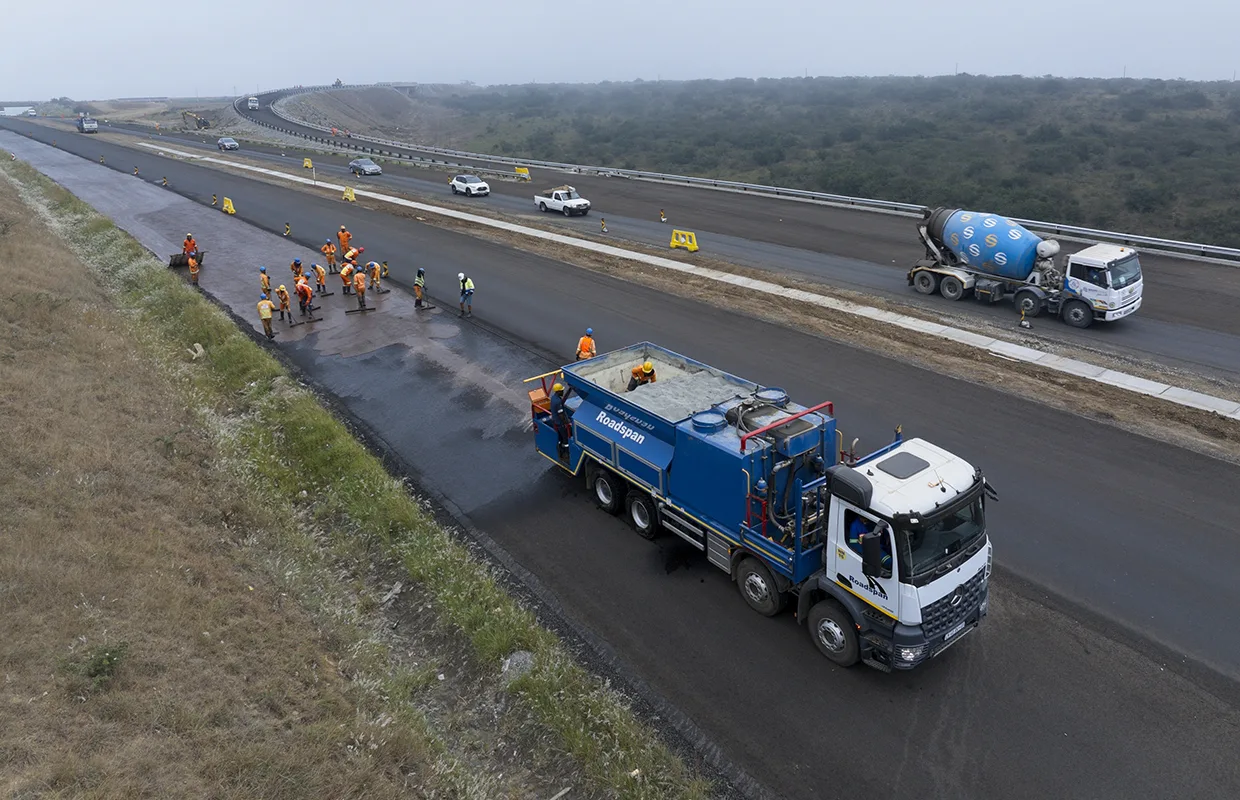CROSS-CONTINENT CONNECTIONS
A story of innovation, the development of the African road network is intrinsically linked to the continent’s socioeconomic progress.
The dynamic history of African road construction began in the Roman era, when Legio III Augusta built the first recorded road in 14 AD between Tacape, a small town at the time, and Ammaedara, considered to be one of the earliest Roman cities in Africa.
The colonial era was when the initial foundations of the continent’s road network were developed, facilitating greater trade and communication across borders before the introduction of motor transport at the beginning of the 20th century.
Indeed, the advent of the internal combustion engine and the evolution of transport and trade via cars and lorries beckoned the need for an improved road network.
As a result, numerous routes were constructed to make way for the many innovations in conveyance that took place in the 1920s, particularly across Northern and Southern Africa.
By the subsequent decade, travel and goods transportation via road were highly common, sparked by concerted government efforts to improve continent-wide economic planning, which elevated the efficiency of the transport network further.
Evidently, the progression of African roads and other supporting infrastructures, such as bridges and civil engineering works, as well as the necessary construction efforts to meet these demands, demonstrate the extent to which roads act as catalysts for modernisation and cultural development.
Despite its continuous growth, the continent’s road network still faces numerous challenges, exacerbated by the rising costs of building materials and labour.
Nevertheless, construction companies across Africa are steadily addressing historical gaps in the continent’s road infrastructure, navigating logistical, geographical, and industrial issues using state-of-the-art technology and cutting-edge machinery, and helping to guide the development of local communities.
FIRST CHOICE CONSTRUCTION PARTNER
One company that has an in-depth understanding of the African construction landscape is WBHO Construction (WBHO), who has become internationally renowned for its transformative building and infrastructure projects across the continent.
The organisation’s operational reach is unlike any other business in Africa, boasting continent-wide and even international projects that span as far as the UK.
Thus, built on firm foundations and an outstanding reputation – as evidenced by its listing on the Johannesburg Stock Exchange (JSE) – WBHO has grown to encompass a vast range of construction and engineering capabilities.
Due to the multitude of sectors that the company’s activities permeate, WBHO comprises three main operational divisions – Building Construction, Civil Engineering, and Roads and Earthworks.
Across its diverse project portfolio, each division proactively works through market challenges by being flexible and cultivating strong, long-lasting relationships with both partners and clients.
As a result, WBHO delivers high-quality projects that enact change throughout the local communities where it operates, creating a legacy of professionalism and collaboration across its works.

EXPERTS IN EARTHWORKS
WBHO Roads and Earthworks (WBHO R&E), in particular, has been a key contributor to the success of its parent organisation.
The division does what it says on the tin, heralding top-notch construction projects across a range of disciplines including bulk earthworks, roadworks and bridges, water and energy infrastructure, and much more, operating with the utmost safety and a highly knowledgeable team.
The typical earthworks process involves several thorough components, including site preparation, in which land is graded and tested to determine the site’s soil moisture content and if the area is safe to complete building work.
Following the necessary approvals, the site goes through clearing and grubbing, where any vegetation or underground roots are removed.
Next, the area must be levelled through the excavation stage, ridding it of any obstacles such as rocks, trees, and waste and ensuring there is a solid foundation for construction works and buildings.
Finally, the embankment process takes place on a specified section of the earth, which is laid and compacted to rise above the surrounding level of the ground. The area is then filled with material that is compacted to create a smooth and stable surface, used to create roads and other transport and logistics infrastructures.
WBHO R&E goes above and beyond for its customers, as the division deeply understands how integral its process is for ensuring the longevity of road, water, and energy infrastructures.
After all, the stronger the foundations, the less likely that major maintenance repairs will need to take place in the future. Thus, WBHO R&E’s work is imperative for negating the potential challenges associated with the African road network.
Furthermore, given that the earthworks process is an integral link in a long chain of construction activities, WBHO R&E permeates a vast range of traditional and specialist engineering disciplines, making its unmatched operational knowledge and advanced capabilities even more critical.
FORGING VITAL ROAD REPAIRS
WBHO R&E has amassed a vast portfolio of projects in the last 50 years that not only demonstrates its state-of-the-art construction capabilities but also highlights the division’s deep understanding of conducting business across Africa.
Indeed, WBHO R&E’s continental presence extends to Sierra Leone, Ghana, Botswana, Eswatini, Lesotho, and South Africa (SA), with the majority of its toll road and freeway improvements taking place in the latter.
In each country of operation, the division helps bring communities together and ensure integral infrastructure is operating at the optimum level for vital goods trade and travel.
For instance, the division recently completed a project on the N3, one of the busiest routes in SA. WBHO R&E rehabilitated a section of the Vaaldraai Interchange, mostly working on the northbound carriageway.
The division likewise resurfaced the R572, a regional road going towards Rooigrond in the North West province. This diverse operation involved a range of construction activities such as establishing gravel shoulders, rut filling, asphalt mill and inlays, edge break repairs, surface patches, and split seals.
It is hoped that these repairs will maintain the road for decades to come, making it safer and more accessible for the community.
In recent years, WBHO R&E also completed an incredible improvement project on the R37 near Burgersfort. This operation is critical to the smooth running of SA’s road network as it is the strategic link between Polokwane, the capital of the Limpopo province, and Mbombela, the capital of the Mpumalanga province.
The project focused on the improvement of Section 2 between Burgersfort and the prominent Modikwa platinum mine, which is part of the Bushveld Igneous Complex that spans nearly 26 kilometres (km) in the Fetakgomo Tubaste Local Municipality.
Elsewhere, WBHO R&E is currently undertaking a four-phase project in the town of Willowvale in the Eastern Cape province. The main objective of this operation is to upgrade the gravel road standards between the town and the rural coastal area of Dwesa.
This project exemplifies the division’s efforts to help those in local communities, as by improving the road surface, thousands of people will have greater access to more amenities and job opportunities.

INNOVATIVE ROAD INFRASTRUCTURE
Alongside the repair of existing routes, WBHO R&E also takes bold steps to construct brand-new structures, elevating the journey for thousands of people every day.
For example, the reconstruction of the Belstone and Breidbach interchanges on the N2 situated between Qonce and the city of East London included two major offramps, with a total rockfill capacity of 200,000 cubic metres (cbm).
The project has also upgraded existing roads and widened the N2 as well as the MR0688 route.
Following its completion, the project has immensely improved driver safety by streamlining traffic flow more effectively whilst also creating a more secure path for pedestrians.
WBHO R&E’s high-calibre work on toll roads and freeways is further demonstrated by the Montrose Interchange, the exclusive east-west route between South Africa and Mozambique, making it a key connection for international trade and travel.
Indeed, the division has greatly improved an at-grade intersection of the Maputo Development Corridor (MDC), converting it to a free-flow systems interchange and streamlining traffic entering the road.
This project proved to be significant for cross-continent economic development, as the division’s work ensured smoother and more efficient major transportation journeys between Johannesburg and Maputo, the capital of Mozambique.
WBHO R&E is likewise proud to be part of a number of highly advantageous bus rapid transport (BRT) system developments and facilitated new public transport routes, as evidenced by the formation of the Rea Vaya BRT system operating in Johannesburg.
The project entailed the relocation of numerous services, construction of two additional BRT lanes, widening of the road, establishment of a pedestrian walkway, as well as the construction of a six-lane bridge.
WBHO R&E was subsequently awarded the construction of the M1 bridge in partnership with the Johannesburg Development Agency (JDA). Not only did this become an integral link in the BRT route, but it remains one of the largest projects that the City of Johannesburg Metropolitan Municipality has ever undertaken, making the project a key milestone for the division.
PIONEERING BULK EARTHWORKS PROJECTS
WBHO R&E has further solidified its reputation for trusted and reliable services with its multitude of highly impressive water and energy infrastructure works.
Notably, the division completed a highly comprehensive stormwater management project and facilitated waste dumps at the Jwaneng mine in Botswana, a major player in the country’s diamond mining industry.
As a major bulk earthworks operation, the project called upon a number of disciplines including civil, structural, and mechanical construction, demonstrating WBHO R&E’s multifaceted approach and wide-reaching expertise.
Therefore, due to the division’s evidenced proficiency, it has worked with some of the world’s most renowned energy and utility companies.
For example, the division completed bulk earthworks on Sasol’s Fine Ash Dam 6 (FAD6) as part of a five-year megaproject with the global energy and chemical titan.
WBHO R&E was awarded a vast range of construction operations at FAD6, including the completion of a high-density polyethylene (HDPE)-lined waste storage facility.
The project secured additional capacity for Sasol’s waste storage facility, catering for the growing levels of generated waste and, thereby extending the life of the company’s operations in Secunda, SA.
WBHO R&E worked extensively with Sasol to ensure its needs were met whilst still allowing the plant to be fully operational. As such, FAD6 was purposefully constructed in phases so that there was still access to the waste storage facility as the project progressed.
The full scope of the megaproject once again required multiple disciplines to commission the facility, including civil, mechanical, electrical, and instrumental capabilities.
The primary dam infrastructure comprised a main ash dam for the delivery of waste slurry as well as a drainage system for capturing reusable water that is transported back to the operations plant.
Overall, the FAD6 project required 1.2 million cbm of earthworks to form the dam embankment and basin, which stretched over 1.6 million square metres (sqm) of HDPE liner, a true demonstration of WBHO R&E’s professionalism and extraordinary capabilities.
Elsewhere, the division has also completed extensive excavation activities at the Elders mine, conducting an underground access operation for Thungela, a leading exporter and producer of thermal coal in SA.
The sheer size of the project required a 1.2 million cbm boxcut excavation, involving the establishment of terraces, access and internal roads, a pollution control and brine dam, civil infrastructure, and a variety of other amenities.

SPECIAL OPERATIONS
In addition to its trusted services in road construction and bulk earthworks operations, WBHO R&E’s special projects are a testament to its industry-leading capabilities.
A notable example is the implementation of geofoam protection over a pipeline at the Clairwood Container Terminal, as well as the development of a new entrance equipped with various services.
As part of this project, the division also constructed a container platform and culvert crossing over two existing pipelines.
Meanwhile, the division has conducted enabling and security works for the Afungi liquefied natural gas (LNG) plant, situated in the Palma District in Northern Mozambique.
This operation required the design, construction, and commissioning of a camp for over 9,500 workers and was specifically designed to embrace comfortable and modern living, utilising an urban flow design.
Moreover, it was constructed to go around the site’s perimeter, totalling 88 hectares upon completion.
The project involved site bulk earthworks, terrace and road construction, as well as the on-site building of furniture and equipment. Furthermore, to guarantee that the workforce had full living amenities, WBHO R&E ensured reliable power distribution, lighting, earthing, internet, satellite TV, and much more.
Additionally, the division completed mass earthworks for the LNG process plant platform, a cut-to-fill operation that involved the clearing of trees and topsoil and reinforcement of concrete paving.
The latter included the construction of a base course at 38,000 cbm, followed by the asphalt paving that measured 19,700 cbm. WBHO R&E also constructed over 38,000 cbm of trapezoidal drains and supplied and laid 550 metres of reinforced concrete pipes.

Finally, WBHO R&E’s LNG activities additionally concerned the design, procurement, and construction of access roads to a resettlement community located near the site in the Afungi peninsula.
Comprising a 30km gravel road, the operation also entailed the upgrade of an existing accommodation camp as well as local office and workshop spaces.
HIGHLY SKILLED PROFFESSIONALS
WBHO R&E’s versatile and expert team utilise top-of-the-range heavy machinery to provide an unparalleled service.
Highly skilled equipment operators are required for heavy and complex machinery as equipment misuse can lead to substantial costs for the division and put staff in danger.
Given the potential risks associated with construction sites and the operation of heavy machinery, the division has developed stringent safety policies, procedures, and initiatives that ensure its team is safe at all times.
On top of this, WBHO R&E has worked hard to foster a culture of security and hazard awareness, which is ingrained in the wider organisation’s ethos of the ‘WBHO Way’, encouraging an open channel of communication at all times to ensure the safety of team members on-site.
By protecting its staff base in their daily activities, the division ensures that each project remains productive and employees feel happy to come to work every day and unlock their construction potential.
This safety ethos is an integral part of WBHO R&E’s shining reputation of excellence, which is one of its greatest assets as it moves forward in the industry.
Additionally, the division works hard to deliver on its shared values of teamwork, communication, and integrity, which filter throughout every area of the business.
WBHO R&E continues on its road to greatness with an unmatched ability to do good across Africa, consistently providing support for the continent’s most crucial road infrastructure and construction activities.



































